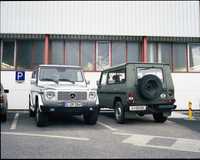Graz / Global
G-force
When it first started rolling into suburban garages and pulling up on gravel country driveways, the term SUV was unknown to fans of the G-Wagen. Twenty-eight years after its launch, the boxy, rugged classic from Austria is one of the most timeless vehicles still in production. Monocle headed to the production line in Graz to watch the craftsmen on the assembly line who hand build G-Wagens – each one to a customer’s precise specifications. This is the chronicle of a design classic’s creation.
The loyalty of Estonian Army generals, Japan’s style-conscious elite and the occasional pope have kept the Mercedes-Benz G-Wagen in production for three decades. Handbuilt in Graz, Austria, at the rate of just 22 a day, they have become perhaps the most desirable four-wheel drive in the world.
The G-Wagen began its life 28 years ago as a simple, rugged off-road vehicle – the term “G-Wagen” is an affectionate contraction of the German Geländewagen (“cross-country vehicle”). It is now, however, the most expensive four-wheel-drive on the market. The current flagship model, the g-55 amg Kompressor, boasts a ticket price of €130,000. Customised, armoured G-Wagens run up to €350,000. Yet, in a world in which all its peers, with the exception of the Land Rover Defender, are affecting smooth, curvy, somewhat effeminate urbanity, G-Wagens are just about the last four-wheel-drive that still looks like a four-wheel-drive – all muscular edges, chunks and corners.
Reasonably enough, the G-Wagen is in great demand from the people who really need such a vehicle – G-Wagens bear the camouflages of the militaries of Canada, Denmark, the Netherlands, Estonia, Finland, France, Germany, Greece, Austria, Hungary, Norway, Luxembourg, Singapore, Switzerland and the United States, and are currently deployed in Iraq, Afghanistan and Kosovo. Of the 3,500 G-Wagens built in an average year, 1,000 are bought by militaries.
The G-Wagen has also found a profitable niche among people who really don’t need such a vehicle. G-Wagens are grown-up Tonka toys in the Gulf States, style statements among the cool crowd in Japan, armoured limousines for US celebrities who find the Humvee off-puttingly gauche. They’re also the object of cultish veneration among their adherents. The president of the German Geländewagen Club, Heinrich Wangler, is not unusual in being a serial owner.
“I have had only five,” he laughs. Wangler has just returned from a two-week club outing to Norway. “One metre of snow, 27 degrees below zero, nine G-Wagens, no breakdowns.” Wangler believes the car’s appeal is a combination of that extreme toughness, and its extreme comfort. “They are luxury vehicles,” he says, “but they are strong. And the design is important. It’s not a normal design. It’s not… round.”
Hall 12 of the vast Magna Steyr auto manufacturing plant in Graz, Austria, is the only place that G-Wagens have been built in the model’s 28-year production history. The 500-odd workers turn out just 22 G-Wagens a day. Every G-Wagen is built to order and every one, whether destined to be a birthday present for a potentate’s spoilt son, or the difference between life and death for a patrol of nato troops in Helmand province, is built by hand. Businesss is pretty good right now, but the G-Wagen may not be around forever. Except, of course, for the G-Wagens which have already been built, which very likely will be.
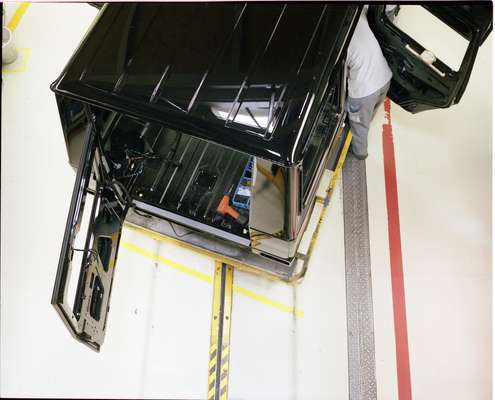
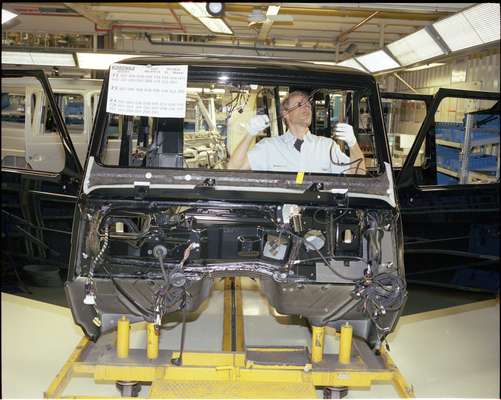

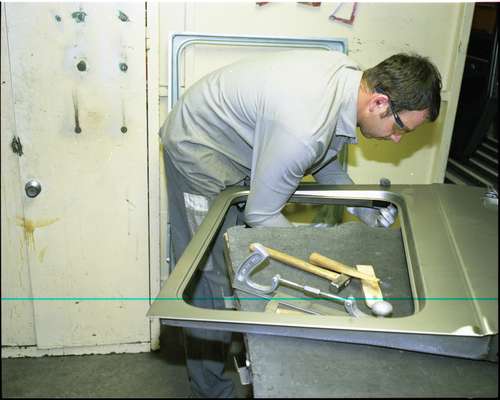
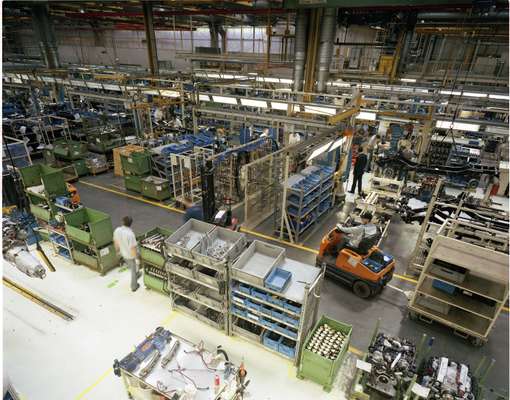
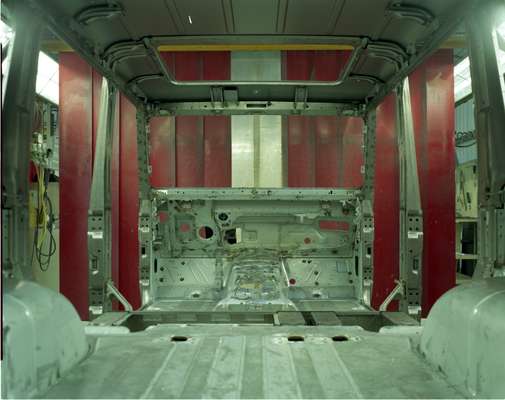
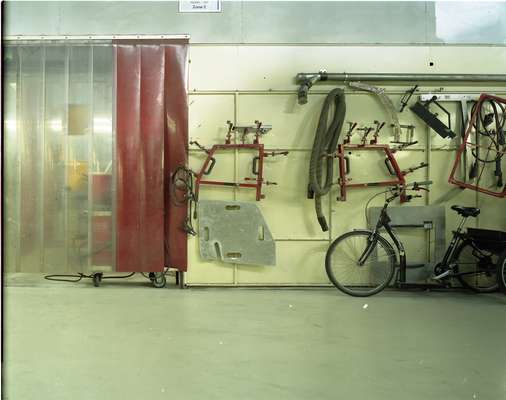
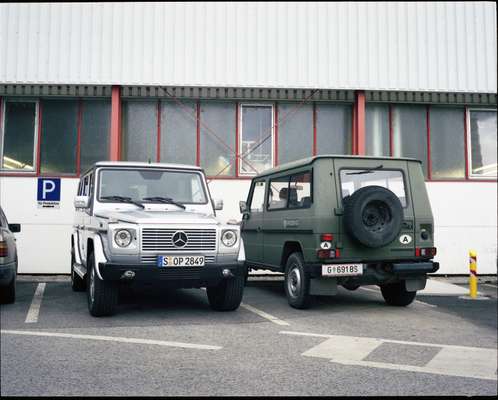
As Jürgen Achilles, senior manager of sales and marketing at DaimlerChrysler (the parent corporation of Mercedes-Benz) explains, the G-Wagen owes its creation to an unlikely progenitor. “The Shah of Iran,” says Achilles, “was a shareholder in Mercedes-Benz, and he was interested in developing a military vehicle.” The Shah encouraged Mercedes-Benz to collaborate with the Austrian manufacturer Steyr-Daimler-Puch, which was already working on a similar vehicle. Prototypes were developed throughout the mid-1970s, and production on the first G-Wagen started in Hall 12 in February 1979.
Mercedes-Benz had what they wanted – a vehicle that slotted into the four-wheel-drive market between the Land Rover and the Range Rover, and they also had a keen and lucrative new market among the world’s militaries.
The first khaki G-Wagens were ordered by the Argentinian army in 1980. A couple of years later, as the Union Jack was re-hoisted over the Falklands, the British A0rmy acquired several but the UK market has remained largely impervious to the G-Wagen’s charms.
Between 1979 and 1999, the G-Wagen was sold under two different brands. In the West, the G-Wagen sported the Mercedes-Benz emblem. East of the Iron Curtain, due to the Soviet bloc’s official horror of the capitalist Mercedes-Benz marque, it was called the Puch (for logistical reasons the G-Wagen also went by the more modest Puch name in Austria and Switzerland). In the automobile museum in Riga, Latvia, one of the star exhibits is the Mercedes G-Wagen once owned by the East German dictator Erich Honecker, its every tri-star punctiliously removed.
Achilles is keener to talk up the G-Wagen’s current famous owners: Benedict xvi (the Pope Mobiles are modified G-Wagens) and Graz’s other famous export, Arnold Schwarzenegger. Achilles emphasises that Mercedes-Benz’s marketing of the G-Wagen is wilfully restrained, just the odd magazine spot. Of more value to the brand, he says, are the expeditions run by the G-Wagen owners’ clubs. Two or three times a year, dozens of G-Wagen drivers load their cars on to boats or cargo planes, and travel en masse to Tunisia, Namibia, Canada, Ireland, France or Australia. “And when,” says Achilles, “you have 20 G-Classes parked together, people stop and look, and they want to know what’s going on, and they want to talk about the cars.”
Mercedes would certainly never, he stresses, dream of exploiting the G-Wagen’s military application, not even when it’s the best advertising imaginable.
In November 2005, an armoured G-Wagen belonging to the Canadian army had a bomb detonated underneath it by Taliban malcontents outside Kandahar. All four occupants – three soldiers and a journalist – survived the blast, which destroyed the front end of the vehicle. “That was a proud day,” says Johann Sattler, the executive manager of G-Class production at Magna Steyr.
The process of assembling a G-Wagen takes place in 25-minute steps, known as “stations”. At each station, mechanics fuss and fiddle briskly and intently. They work one shift a day, from 06.00 to 14.30. Many of the people who build it have done nothing else.
“All of them,” smiles 28-year-veteran Joseph Knopf, when asked how many of the 195,000 extant G-Wagens he’s worked on. At present, his role is overseeing the internal wiring of all the vehicles, and the modifications to the armoured versions (also popular with ngos and the more paranoid owner).
Knopf shows me down the line of partly built cars. Usually, only Owners’ Club members and prospective buyers get to see this, he explains. It’s an unusual assembly line in that the sequence is random. Because the G-Wagens are built to order, a worker can find himself confronted by a sequence of red short-wheelbase convertible plaything followed by green armoured long-wheelbase desert warrior followed by white four-door hotel courtesy vehicle destined for Japan. They don’t have any charts or instruction manuals.
“All in our heads,” says Knopf. “And the car just gets better and better. Those first ones were absolutely basic, but now this is a classic, absolutely impressive.” Asked if he drives one himself, Knopf laughs. “Too expensive,” he says – even the entry-level G-320 diesel starts at €62,000. “But I’d be very proud if I did.”
The G-Wagen’s biggest market is the US, followed by Germany and Japan, though business is picking up in the Gulf States, Russia and China. The vehicle has become a unique automotive barometer of cultural quirks. In the Gulf States, G-Wagens tend to be white, the better to deflect the heat – one sheikh had his convertible fitted with an elevatable dentist’s chair, to abet his falconry. In Japan, where 700 were sold last year, G-Wagens are treasured because they are left-hand-drive – a European car somehow hints at status and success. In Europe, they are beloved of hunters, one of whom demanded that his G-Wagen be upholstered in the skin of deer he’d shot. One Middle Eastern customer insisted that the standard G-Wagen test run be carried out by a fellow Muslim. “So we found him one,” says Achilles.
Given the full order book, the global fanbase, the iconic stature of the brand and the palpable pride of the people who build it, it seems preposterous to consider the end of the G-Wagen – but Mercedes-Benz did, as recently as three years ago. The current military contracts were complete. Hall 12’s antiquated and specialised machinery was becoming difficult and expensive to maintain, let alone bring into line with new EU emissions standards. The 25th anniversary of the G-Wagen loomed as a convenient cut-off point. The workers were told, as were dealers and the owners’ clubs. “And we got 2,000 enquiries,” remembers Achilles, “from people saying they wanted to buy one last G-Class.”
At the moment, Hall 12 is scheduled to keep building G-Wagens until 2010. As for the future beyond that, nobody projects much more than a nervous sort of hope. Anyone wishing to own a genuinely iconic vehicle – especially one with deerskin seats, a falcon perch, or the blessing of an approved co-religionist – would be well advised to hurry.

